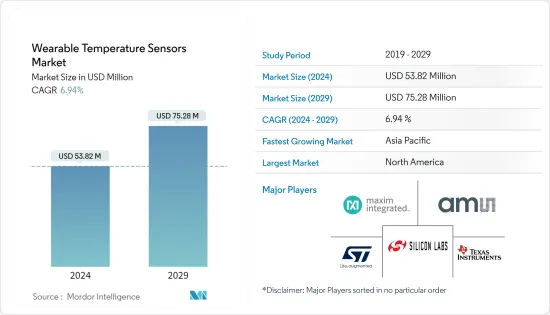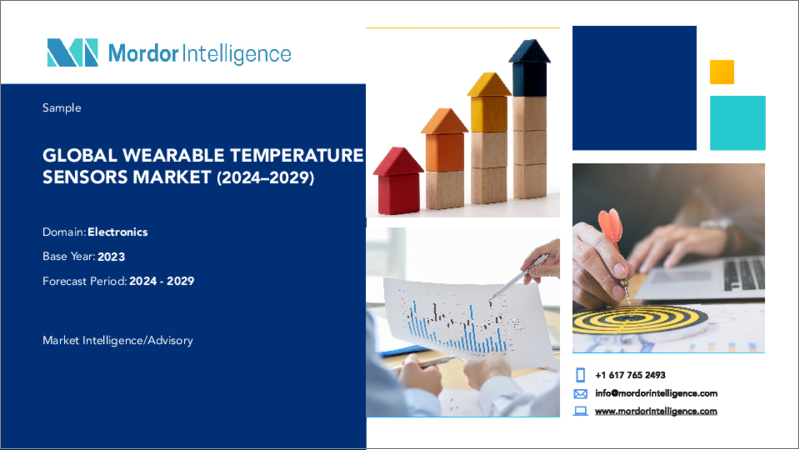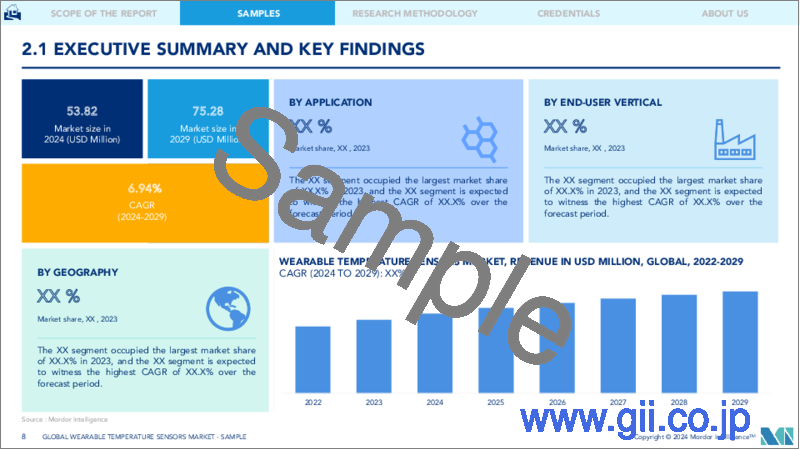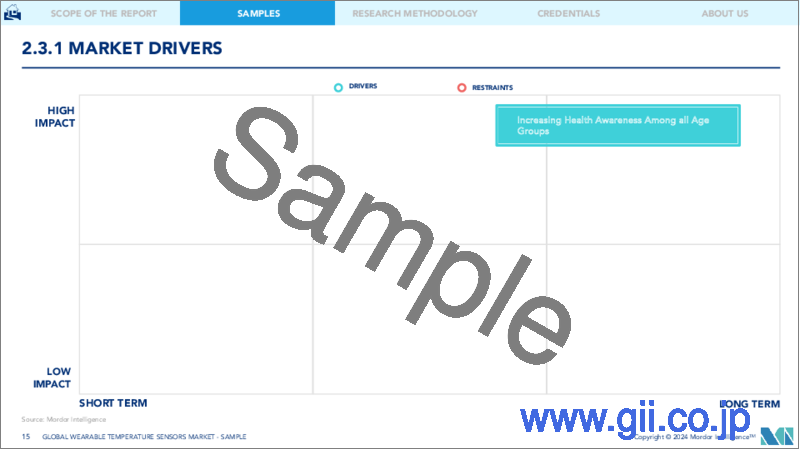|
|
市場調査レポート
商品コード
1432820
ウェアラブル温度センサー:市場シェア分析、産業動向と統計、成長予測(2024~2029年)Wearable Temperature Sensors - Market Share Analysis, Industry Trends & Statistics, Growth Forecasts (2024 - 2029) |
||||||
|
● お客様のご希望に応じて、既存データの加工や未掲載情報(例:国別セグメント)の追加などの対応が可能です。 詳細はお問い合わせください。 |
|||||||
| ウェアラブル温度センサー:市場シェア分析、産業動向と統計、成長予測(2024~2029年) |
|
出版日: 2024年02月15日
発行: Mordor Intelligence
ページ情報: 英文 120 Pages
納期: 2~3営業日
|
- 全表示
- 概要
- 目次
ウェアラブル温度センサー市場規模は、2024年に5,382万米ドルと推定され、2029年には7,528万米ドルに達すると予測され、予測期間(2024-2029年)のCAGRは6.94%で成長すると予測されます。

スマートウェアラブルデバイスの普及拡大、IoTやARプラットフォームの普及拡大、小型化動向の高まり、コネクテッドデバイスの普及などが、調査期間中にウェアラブル温度センサーの市場成長を促進すると予測される主な要因です。
主なハイライト
- スマートライフの急速な動向とコネクテッドデバイスの増加は、ウェアラブル温度センサー市場の成長を促進すると予想されます。これらのウェアラブル温度センサーは、心拍数、体温、脈拍数などの様々な健康面を継続的にモニターすることができます。
- アップル、サムスン、マイクロソフトなどの大手企業がウェアラブル技術市場に参入したことで、家電業界におけるウェアラブルセンサー技術の需要も、顧客からの強い要望により急速に増加しています。
- ICTと医療分野の融合は、ヘルスケアサービスを向上させるシームレスに接続されたセンサーとデバイスの出現を反映しています。ヘルスケア分野で使用されるウェアラブルへのセンサーの統合は、高度な医療機器をサポートする高い需要とともに増加し、それによってヘルスケア分野での重要性を高めています。
- さらに、あらゆる年齢層の人々のフィットネスと健康に関する意識の高まりが、ウェアラブル温度センサーの成長を促進しています。遠隔ケア・モニタリングへの動向が、ウェアラブル・デバイスを搭載した温度センサーの需要を牽引しています。いくつかの新興企業は、温度センサーを直接製造したり、間接的に自社のソリューションに組み込んだりして、多額の資金を獲得しています。
- ウェアラブルセンサーは、血圧、心拍数、体温といったいくつかのパラメータが極めて重要なヘルスケアおよび診断業界で大きな人気を得ています。老人人口の増加とヘルスケア分野におけるウェアラブルデバイスの利点の増加は、予測期間を通じて市場の開拓を加速すると予測されています。
ウェアラブル温度センサー市場動向
腕時計型ウェアラブルが大きく成長
- スマートウォッチは、快適性、利便性、安全性、健康状態のモニタリングなどの機能により、一世を風靡しました。その結果、心拍数、手首の脈拍、動作、血圧、眼圧、その他の健康状態のモニタリングなど、人体とのインタラクションが容易なスマートウォッチが注目を集めています。
- また、体温のリアルタイムモニタリングは、心臓発作などの突発的な有害事象を認識するために極めて重要です。さらに、体温モニタリングは、身体活動がその達成に直接関係する場合に不可欠です。このように、スマート手首ウェアラブルはこれらの要件をすべて満たしており、手首ウェアラブル市場の創造に役立っています。
- テキサス・インスツルメンツなどのセンサーメーカーが、スマートウォッチやフィットネストラッカーでの温度センサー機能の使用をサポートしているため、これらのセンサーの使用は今後さらに増加すると予想されます。例えば、LMT70ウェアラブル・デザインは、スマートウォッチやフィットネストラッカーの中に収まる小さなフォームファクターの電気システムを使用しており、20℃~42℃の人体温度範囲で0.1℃の精度で人の皮膚温度と室温の両方を測定します。
- しかし、体温の測定やモニタリングは、現在進行中のCOVID-19パンデミックの影響もあり、ウェアラブルにとって重要な課題となっています。高体温(37.8℃以上)は呼吸器疾患の一般的な症状のひとつです。このようなウェアラブル温度センサーの用途は、スマートウォッチの需要増加と相まって、ウェアラブル温度センサー市場の世界の成長に貢献すると期待されています。
アジア太平洋が最速の成長を遂げる
- アジア太平洋は、中国やインドといった人口の多い国の存在により、最も速い成長を記録すると予想されています。この2カ国では、可処分所得の増加がウェアラブル温度センサー市場の成長を補完する役割を果たすと思われます。
- プルデンシャルとエコノミストによる「アジアの健康バロメーター2020」レポートによると、アジアの13カ国からの調査回答をまとめたもので、回答者の78.5%が何らかのパーソナル・ヘルス・テクノロジーを利用しています。
- さらに、技術の進歩は、スマートウォッチにセンサーを組み込み、アンドロイドやiOSのアプリを使って変化をモニターする革新的なアイデアをウェアラブルメーカーに促しました。
- さらに、COVID-19はアジア太平洋地域のウェアラブルデバイスにおける温度センサーの需要を加速させ、多くのベンダーがこの需要に対応する製品を発売しています。
- 2021年4月、タイメックスはインドでfit健康モニタリングスマートウォッチを発売しました。このウェアラブルには、遠隔医療、体温をモニターする温度センサー、SpO2モニターなど、多数の健康・フィットネス機能が搭載されています。
その他の特典:
- エクセル形式の市場予測(ME)シート
- 3ヶ月間のアナリスト・サポート
目次
第1章 イントロダクション
- 調査の前提条件と市場定義
- 調査範囲
第2章 調査手法
第3章 エグゼクティブサマリー
第4章 市場洞察
- 市場概要
- 業界の魅力度-ポーターのファイブフォース分析
- 供給企業の交渉力
- 消費者の交渉力
- 新規参入業者の脅威
- 代替品の脅威
- 競争企業間の敵対関係
- 業界バリューチェーン分析
- COVID-19の業界への影響評価
第5章 市場力学
- 市場促進要因
- あらゆる年齢層における健康意識の高まり
- スマートガジェットにおける高機能センサーの増加
- 市場の課題
- 高い製品コスト
第6章 市場セグメンテーション
- アプリケーション
- ボディウェア
- アイウェア
- フットウェア
- リストウェア
- その他の用途
- 業界別エンドユーザー
- ヘルスケア
- スポーツ/フィットネス
- 産業用
- その他エンドユーザー業界別
- 地域
- 北米
- 欧州
- アジア太平洋
- 世界のその他の地域
第7章 競合情勢
- 企業プロファイル
- Silicon Laboratories Inc.
- Maxim Integrated Products Inc.
- STMicroelectronics NV
- Texas Instruments Inc.
- AMS AG
- Melexis
- Analog Devices Inc.
- GreenTEG
- TE Connectivity Ltd
- Sensirion AG
第8章 投資分析
第9章 市場の将来
The Wearable Temperature Sensors Market size is estimated at USD 53.82 million in 2024, and is expected to reach USD 75.28 million by 2029, growing at a CAGR of 6.94% during the forecast period (2024-2029).

The expanding reach of smart wearable devices, increased penetration of IoT and AR platforms, the rising trend of miniaturization, and the popularity of connected devices are some of the major factors that are expected to drive the market growth of wearable temperature sensors during the study period.
Key Highlights
- The rapidly increasing trend of smart living and the increasing number of connected devices is anticipated to enhance the wearable temperature sensors market growth. These wearable temperature sensors are able to continuously monitor various health aspects, such as heart rate, body temperature, and pulse rate.
- With the entrance of big players, such as Apple, Samsung, and Microsoft, into the wearable technology market, the demand for wearable sensor technology in the consumer electronics industry has also multiplied rapidly, owing to the strong demand from its customers.
- The convergence between ICT and medical fields reflects the emergence of seamlessly connected sensors and devices that can improve healthcare services. The integration of sensors in wearables used for the healthcare sector increases with a high demand to support advanced medical equipment, thereby making it significant in the healthcare sector.
- Moreover, enhanced awareness regarding fitness and health in people of all age groups has been driving the growth of wearable temperature sensors. The trend toward remote care monitoring is driving the demand for temperature sensors equipped with wearable devices. Several startups are gaining significant funding which directly manufactures temperature sensors or indirectly incorporates them into their solution.
- Wearable sensors have gained significant popularity in the healthcare and diagnosis industry, where several parameters are of vital importance, namely blood pressure, heart rate, and body temperature. The growing geriatric population and the increasing number of advantages of wearable devices in the healthcare segment are projected to accelerate the development of the market throughout the forecast period.
Wearable Temperature Sensors Market Trends
Wrist Wearables To Have Significant Growth
- Smartwatches have taken the world by storm owing to the features such as human comfort, convenience, security, and monitoring health conditions offered by these watches. As a result, smartwatches are receiving greater attention because of their facile interaction with the human body, such as monitoring heart rate, wrist pulse, motion, blood pressure, intraocular pressure, and other health-related conditions.
- In addition, real-time monitoring of body temperature is crucial for recognizing sudden adverse occurrences, such as heart attacks. Furthermore, temperature monitoring is essential where physical activity is directly concerned with their accomplishment. And thus, smart wrist wearables fulfill all these requirements, which help in creating a market for wrist wearables.
- With sensor manufacturers, such as Texas Instruments, supporting the use of temperature sensor capabilities in smartwatches or fitness trackers, the use of these sensors is expected to increase further in the future. For instance, the LMT70 Wearable Design uses a small form factor electrical system that fits inside a smartwatch or fitness tracker that measures both human skin and room temperatures with an accuracy of 0.1°C in the human body temperature range of 20°C-42°C.
- However, measuring or monitoring body temperature is a topical subject for wearables in current times, mainly because of the ongoing COVID-19 pandemic. A high temperature (37.8C or greater) is one of the common symptoms of respiratory illness. Such applications of wearable temperature sensors, coupled with the increase in the demand for smartwatches, are expected to contribute to the growth of the Wearable Temperature Sensors Market globally.
Asia-Pacific to Witness the Fastest Growth
- Asia-Pacific is anticipated to register the fastest growth because of the presence of two highly populated countries such as China and India. In these two countries, the increase in disposable income will act as a supplement for the growth of the wearable temperature sensors market.
- According to the Health of Asia Barometer 2020 report by Prudential and the Economist, a collection of survey responses from 13 countries in Asia, 78.5% of respondents use some form of personal health technology.
- Moreover, advancements in technologies have encouraged wearable manufacturers to come up with innovative ideas to embed the sensors into smartwatches and monitor the changes using Android and iOS apps.
- Further, COVID-19 accelerated the demand for temperature sensors in wearable devices in Asia-Pacific, and many vendors are launching products to meet this demand.
- In April 2021, Timex launched its fit health monitoring smartwatch in India. The wearable comes with numerous health and fitness features, including telemedicine, a temperature sensor to monitor the body's temperature, and a SpO2 monitor.
Wearable Temperature Sensors Industry Overview
The wearable temperature sensors market is moderately fragmented. Some of the global key players in this market are Silicon Laboratories, Maxim Integrated Products Inc., Texas Instruments Inc., STMicroelectronics N.V., and AMS AG. Product launch, acquisition, and partnership are some of the key strategies adopted by market players operating in the wearable sensors industry. Some of the recent developments are:
- March 2022 - AMS OSRAM established a new research and development center in Bucharest, Romania. The new facility would focus on the research and development of integrated circuitry to deliver state-of-the-art solutions focusing on consumer applications, including sensor technology for wearable technology for fitness and exercise, smartphones, 3D authentication, and payment.
Additional Benefits:
- The market estimate (ME) sheet in Excel format
- 3 months of analyst support
TABLE OF CONTENTS
1 INTRODUCTION
- 1.1 Study Assumptions and Market Definition
- 1.2 Scope of the Study
2 RESEARCH METHODOLOGY
3 EXECUTIVE SUMMARY
4 MARKET INSIGHTS
- 4.1 Market Overview
- 4.2 Industry Attractiveness - Porter's Five Forces Analysis
- 4.2.1 Bargaining Power of Suppliers
- 4.2.2 Bargaining Power of Consumers
- 4.2.3 Threat of New Entrants
- 4.2.4 Threat of Substitutes
- 4.2.5 Intensity of Competitive Rivalry
- 4.3 Industry Value Chain Analysis
- 4.4 Assessment of COVID-19 Impact on the industry
5 MARKET DYNAMICS
- 5.1 Market Drivers
- 5.1.1 Increasing Health Awareness Among all Age Groups
- 5.1.2 Increasing Growth of Advanced Functions Sensors in Smart Gadgets
- 5.2 Market Challenges
- 5.2.1 High Product Cost
6 MARKET SEGMENTATION
- 6.1 Application
- 6.1.1 Body Wear
- 6.1.2 Eye Wear
- 6.1.3 Foot Wear
- 6.1.4 Wrist Wear
- 6.1.5 Other Applications
- 6.2 End-user Vertical
- 6.2.1 Healthcare
- 6.2.2 Sports/Fitness
- 6.2.3 Industrial
- 6.2.4 Other End-user Verticals
- 6.3 Geography
- 6.3.1 North America
- 6.3.2 Europe
- 6.3.3 Asia Pacific
- 6.3.4 Rest of the World
7 COMPETITIVE LANDSCAPE
- 7.1 Company Profiles
- 7.1.1 Silicon Laboratories Inc.
- 7.1.2 Maxim Integrated Products Inc.
- 7.1.3 STMicroelectronics NV
- 7.1.4 Texas Instruments Inc.
- 7.1.5 AMS AG
- 7.1.6 Melexis
- 7.1.7 Analog Devices Inc.
- 7.1.8 GreenTEG
- 7.1.9 TE Connectivity Ltd
- 7.1.10 Sensirion AG




